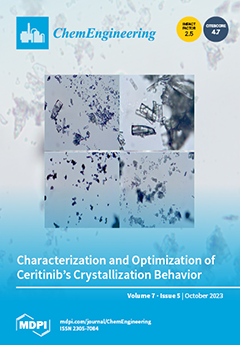The availability of fossil energy is dwindling, so renewable fuels are the alternative choices, one of which is bioethanol. To increase the purity of the ethanol produced via the fermentation process, activated carbon (AC) was made from durian (
Durio zibethinus) peel.
[...] Read more.
The availability of fossil energy is dwindling, so renewable fuels are the alternative choices, one of which is bioethanol. To increase the purity of the ethanol produced via the fermentation process, activated carbon (AC) was made from durian (
Durio zibethinus) peel. The steps for making AC consist of carbonization (300 °C and 400 °C), chemical activation using phosphoric acid (10–40%), pyrolysis (700 °C and 800 °C), and neutralization. The results showed that the maximum surface area (326.72 m
2/g) was obtained from 400 °C carbonization, 800 °C pyrolysis, and activation using a 40% phosphoric acid solution. Other characteristics are the surface area of 326.72 m
2/g, pore radius of 1.04 nm, and total pore volume of 0.17 cc/g with phosphate residue in the form a P
2O
5 molecule of 3.47% by weight, with COOH, OH, CO, C=C, C=O, P-OC, and Fe-O groups with wavenumbers (cm
−1), respectively, of 3836, 3225, 2103, 1555, 1143, and 494. The AC also demonstrated the highest number of carbon (86.41%) upon detection using EDX, while XRF analysis verified an average carbon content of 94.45 wt%. The highest ethanol adsorption efficiency (%) and the lowest yield (%) of AC (%) were 90.01 ± 0.00 and 23.26 ± 0.01. This study shows that durian peel has great potential as the raw material for the activated carbon manufacture of ethanol adsorbents.
Full article





